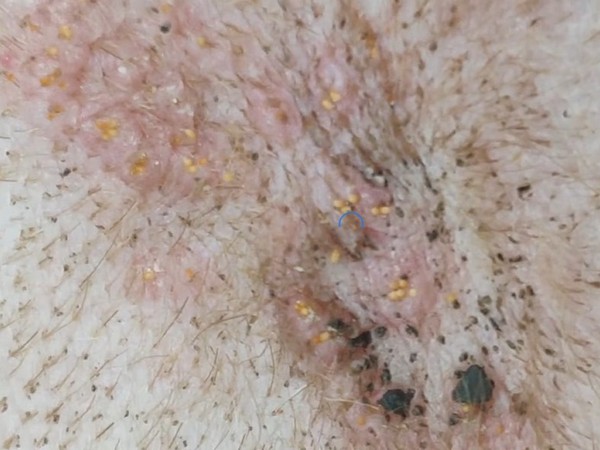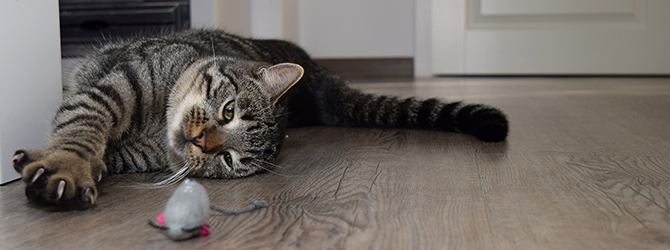Harvest mites on cats
Cats who spend time outdoors, especially in the countryside or in gardens with long grass, are at the highest risk of being infested by the larvae of harvest mites (also called chiggers or berry bugs). These tiny orange parasites tend to live in areas with long grass, woodland, and chalky soils. They're most active during dry, sunny days from late summer to early autumn.
The larvae are about 0.2mm long, making them just visible to the naked eye. They latch onto cats when they brush against infested vegetation and are particularly drawn to areas with thinner skin, such as the ears, tummy, face, neck, shoulders, or between the toes.
What are harvest mites?
Harvest mites belong to the Trombiculidae family. They're most noticeable when they're in their larval stage, which is the only time they cause problems for animals or humans. These larvae, which haven't yet fully developed into adult mites, attach themselves to cats and other warm-blooded animals. They feed by piercing the skin and releasing enzymes that break down skin cells, which they then eat. Unlike some other parasites, harvest mite larvae do not burrow into the skin or feed on blood.
After feeding for two to three days, the larvae drop off, leaving behind swollen, irritated and itchy skin. Adult harvest mites then live freely, feeding on decaying plants.
How do harvest mites affect cats?
Harvest mites can cause real discomfort in cats, mostly through intense itching. Due to irritation and scratching, your cat's skin may become red, inflamed, and crusty. In severe cases, your cat may also develop raw sores through scratching, putting them at risk of infection. These infections occur when the skin is broken, allowing bacteria to enter. If left untreated, they can cause further complications and may even result in sepsis, a life-threatening condition where bacteria enter the bloodstream — although this is, thankfully, a very rare complication.
Diagnosing harvest mites in cats
Diagnosing harvest mites in cats can be difficult as the symptoms, such as itching and redness, are similar to other skin conditions. It's also common for cats to swallow the orange larvae while grooming, making it difficult for owners to spot them.
If you do notice small orange dots on your cat's skin, especially in areas with less hair, it's a strong sign they may be infested by harvest mites. Your vet may take a skin scraping and examine it under a microscope to identify the larvae.
Pictures of harvest mites on cats


How to get rid of harvest mites on cats?
While no products are specifically licensed for treating harvest mites in the UK, some options have proven effective. Sprays or spot-ons containing fipronil — a common ingredient in flea treatments — are commonly used, although repeat applications may be needed to get rid of all the mite larvae.
Your vet may also prescribe steroids or anti-inflammatories, either as a tablet, injection or topical cream, to reduce inflammation and severe itching. If any of the affected areas have become infected, antibiotics will be prescribed.
Cats with sensitive skin or those prone to allergies may be more severely affected by harvest mite bites. These cats are more likely to experience intense itching, skin irritation, and self-trauma, requiring more intensive care and management.
Preventing harvest mites in cats
Following these tips should help prevent your cat from being infested by harvest mites:
- Try to keep your cat away from long grass and woodland areas during high-risk periods (middle of the day on warm, dry days in late summer and autumn).
- Regularly check your cat for signs of mites.
- Use preventive treatments prescribed by your vet.
- Maintain your garden by mowing the grass and reducing dense vegetation.

Frequently asked questions
Can humans get harvest mites from cats?
Harvest mites can bite humans, but they don't transfer directly from cats to humans. Instead, humans and cats can pick them up from the same environment.
Can I treat harvest mites at home?
It’s best to follow your vet's advice. You may need to use a cone collar to stop your cat from scratching the affected areas. Bathing sore skin with a mild salt solution (1 teaspoon of salt in 500 ml of boiled, cooled water) can also help soothe irritation. If your cat is itchy and uncomfortable, seek veterinary advice.
How long does it take for harvest mites to go away?
With proper treatment, the symptoms caused by harvest mites usually improve within a few days to a couple of weeks.
Are some cats more susceptible to harvest mites?
Cats that spend more time outdoors in affected areas are at higher risk, and those with sensitive skin may experience more severe reactions.
Need more advice on harvest mites on cats?
For expert advice on harvest mites on cats, visit our find a vet page to locate your nearest vet, or speak to a vet online using our video vet service.
Prevention is always better than cure, so start protecting your cat today. Pet Health Club members get 10% off flea and tick treatments, which can also help manage mites.


